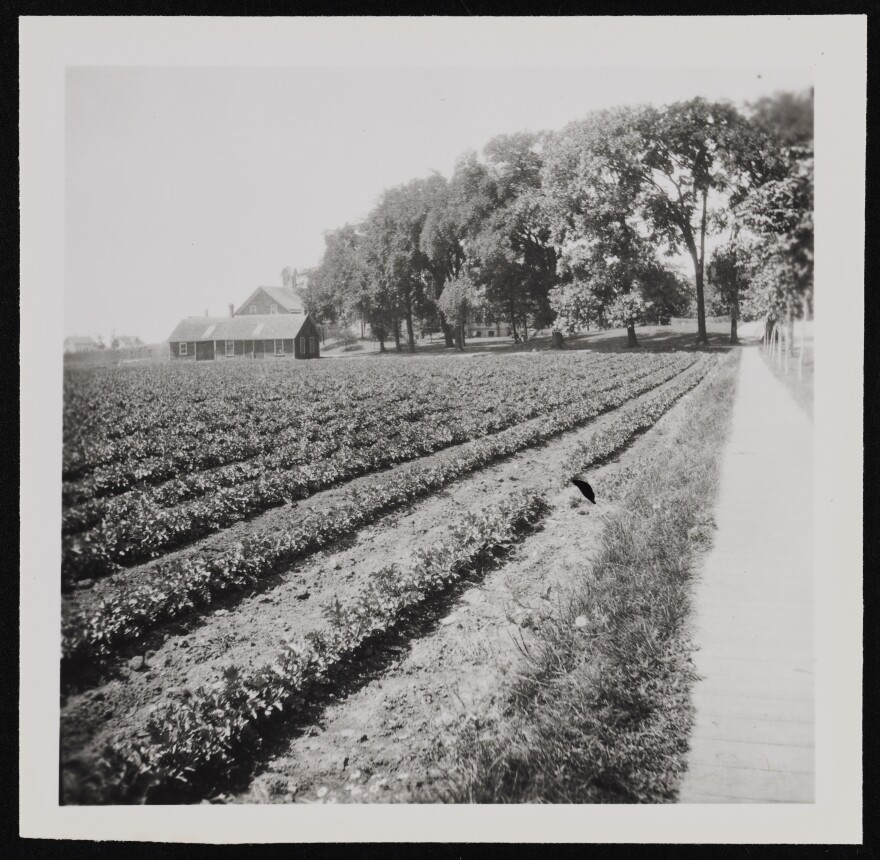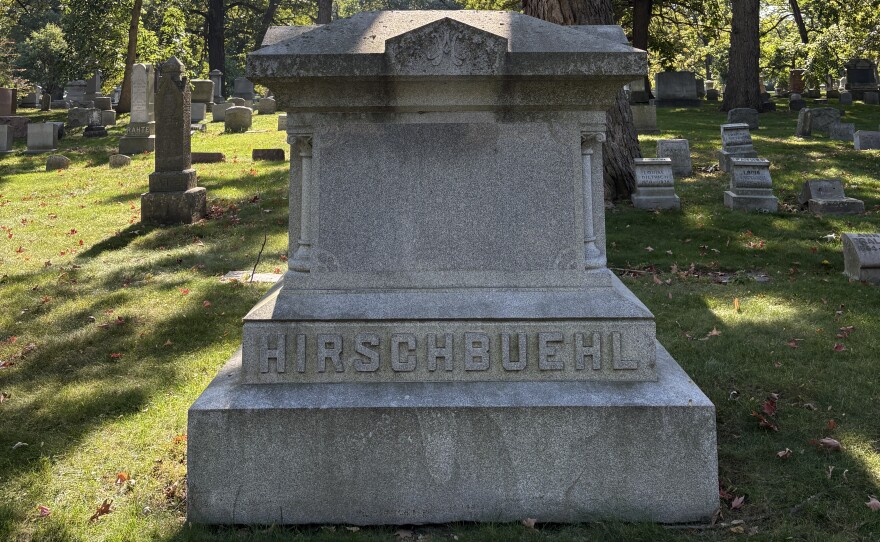Celery is green, crunchy and flavorful. But did you know it also has a history in Milwaukee?
Carol Kaminski says she was told there was once a celery farm north of Mitchell Field, and she’s been wondering about it for years — until she finally reached out to Bubbler Talk.
“I’m having a hard time believing that [story] because it’s celery,” Kaminski says. “Celery? In Milwaukee? Our soil isn’t designed for celery. So I would like to know if this is even remotely true, or what, in fact, was there?”
To investigate this, I started by scouring through old newspaper articles.
I found stories of two different celery farmers in Milwaukee, and as it turns out, both are buried at Forest Home Cemetery.
Cyndi Kramer, a volunteer docent at the cemetery, had recently been researching Wisconsin’s ties with celery. She met me at the gravestone of Egon Hirschbuehl, a celery farmer of Milwaukee’s past.
“Egon is the son of Anton Hirschbuehl, who was one of the very first doctors in Milwaukee,” she says. “Egon married Amelia Dietrich, and her father, Louise Dietrich, owned a farm down by today’s airport. It wasn’t a celery farm at that time, but at some point Egon made it a celery farm.”
She says Hirschbuehl owned a 56-acre celery farm at what is now the northwest corner of the Milwaukee Mitchell International Airport.
According to old Milwaukee Journal articles, Hirschbuehl’s farm was eventually bought in 1920 by Thomas Hamilton, a local propeller and airplane maker. He turned it into a small airport called Hamilton Airfield.
In 1926, the Milwaukee County Board of Supervisors purchased Hamilton’s Airfield for $150,000. In 1927, Milwaukee’s first airport terminal, named the Hirschbuehl Farmhouse, opened on the site. The county eventually renamed the airport General Mitchell Airport in 1941.
Kramer, the volunteer docent, says that’s just the story of one celery farm.
“The biggest celery farm in Wisconsin was actually by Appleton,” she says. “But there was one in Eau Claire, and there were several here in Milwaukee. There were also some in Kenosha and Racine. So it was a very popular crop at some point.”
Milwaukee’s Celery King
Another local celery farmer who made a name for himself is Henry Griswold Comstock. He was known as the “Celery King of Milwaukee.”
According to a 1975 Milwaukee Journal profile story, Comstock started his farm in the south side of Milwaukee in the late 1800s. It was 250 acres, from West Forest Home Avenue to West Orchard Street and from South 32nd to South 37th Street. In 1900, it was worth $50,000, which is nearly $2 million today.
Kramer says Polish immigrants would help Comstock harvest the celery. But as the area became more populated, farms gave way to housing and businesses.

“There was a lot of new Polish immigrants coming into the city,” Kramer says. “They were looking for work, and [Comstock] could provide that work space for them. It might also be part of [Comstock’s] downfall, because as the business grew, their need for labor grew. And the area around the farm developed very quickly into a residential and commercial support system for the workers.”
Comstock’s daughter, Mabel Comstock Summers, was interviewed in the 1950s as part of Milwaukee on Camera, a program produced by the Milwaukee Public Library. Host Bruce Kanitz asked about her father’s celery farm.
“About that time, celery was being raised in Kalamazoo, Michigan, and father realized that celery did well on muck land,” she says. “He also realized we had muck land in his 40s. So he cleared [his land] and produced these very fine fields of celery. After he exhausted the supplies he had on his own place, he then rented any land that he could get in the neighborhood, 100 acres or more.”
Milwaukee’s Peaty Soil
Mabel refers to muck land — which is black, muddy soil, typically found in bogs. It’s also known as peat soil.
To learn more about what it takes to grow celery, I spoke with Ann Kowenstrot, a diversified vegetable and emerging crops educator with the UW-Madison Extension. She says celery is 95% water, which means it needs a lot of consistent moisture to grow.
“The roots of celery are fairly shallow – they're only 2-4 inches from the surface, so if it does dry out, it can severely impact those roots,” Kowenstrot says. “So [celery] grows well in what we call muck soils, which are soils that are very high in organic materials. These muck lands are usually drained swampy areas, where the underlying soil that celery is growing in is consistently moist, and that helps the plant grow.”
The way Milwaukee developed these muck soils and peat bogs can be traced to the Ice Age.
Elmo Rawling is a professor and quaternary geologist at the UW-Madison Division of Extension and Wisconsin Geological and Natural History Survey. He says Milwaukee had a history of glaciers moving in and melting off during the last Ice Age. Those glaciers would fluctuate in size, which would leave behind both silty clay and sandy sediment.
The glaciers also shaped Milwaukee’s irregular topography — leaving us with small hills and undrained dips — which form marshy areas, like peat bogs.
“If you have a silty clay, that water is going to pool up on the surface,” Rawling says. “The other thing the glacier does is give you a little bit of topography so that the low areas are places where water will accumulate. That'll give you a wet environment where you're going to accumulate organics over time that are going to give you that bog soil that is good for things like celery.”
Peat and muck soils are great for growing water-dense vegetables like celery, but not so great for building stuff on.
According to a 1975 Milwaukee Journal article, Milwaukee Recreation’s Burnham Playfield sits where Comstock’s celery used to grow.
When the park was renovated in 2022, Pam Zimmerman, coordinator for Milwaukee Rec’s Facility Design and Development team, says she didn’t expect to find peaty soil under the park when they tested it. She says Milwaukee Rec had to install structural support to hold up the renovated playfield.
“Walking on the surface, you didn't realize how organic and mucky the soils were,” Zimmerman says. “So as we got into the middle of that construction project, if you dug a hole, the soil would slump… so that's one reason we needed all the rammed aggregate geopiers. We had to do a lot of stabilization to get the utility manholes and playground equipment in.”
Celery in Wisconsin today
So, with mucky soil found in different pockets of Wisconsin, why isn’t celery widely grown in the state today?
John Bobek is one of the only large-scale celery farmers in the state. He moved to Wisconsin from Indiana in 1989 to buy farm land with peat soil. He currently farms in Green Lake County.
“These muck pockets here that we farm, it’s still probably one of the better places to grow peppermint or spearmint, and that's what we were after at that time,” Bobek says. “I don't grow peppermint or spearmint anymore, but at that time, that's what we were chasing.”

In 2012, Bobek started looking to add a new crop to his rotation. He decided on celery after he learned it had a history in the state and grows well in his soil.
At one point, Bobek had 50 acres of celery. Now he only grows about 15 acres of it and sells it to a processor in Ripon, Wisconsin.
Bobek says growing celery is a challenge he enjoys, but understands why there aren’t more farmers growing celery on a commercial scale in Wisconsin.
“Number one reason is probably the season's too short because it's a fresh crop. Number two is the marketing. Number three is the climate,” Bobek says. “There never was an infrastructure built in Wisconsin for celery. It was never a big enough crop grown here. The California environment is by far superior for growing that type of crop.”
Bobek says Wisconsin has a short window of time to grow celery.
The celery growing process starts in greenhouses in late February to early April. Seedlings are then transplanted and irrigated to help the plant start growing. Bobek says he starts planting in early May, with the last planting in the ground by early July. Harvest then begins around the middle of July and goes until the middle of October.
Bobek says hotter summer nights also make it easier for the celery to rot.
Meanwhile, California grows over 90% of our country’s celery supply. While it’s still a finicky crop to grow, celery thrives in the state’s coastal climate and is grown year-round.
“If I'm a buyer, it's a lot easier to buy from the same person 12 months out of the year than trying to find different providers for different seasons,” Bobek says. “This is kind of the way of the world at the moment.”
Besides Bobek’s farm, celery that’s grown in Wisconsin comes from small farmers and growers. They sell their vegetables directly to consumers at farmers' markets or through a local produce subscription.
A part of Milwaukee’s history of urban agriculture
So, Wisconsin went from having a “Celery King of Milwaukee” to hardly any celery farms. That’s why this was so surprising to Bubbler Talk question asker Carol Kaminski.
“It’s so interesting to learn about the Polish workers,” Kaminski says. “I myself am Polish, and to learn that they came over and harvested celery — I’m grateful they had the opportunity to do that, because it probably wasn’t as big of a shock to come to a new country and have to figure it out.”

Michael Carriere is an urban historian and a history professor at the Milwaukee School of Engineering. He says Milwaukee has a long history of urban agriculture, and its impacts can still be felt today.
“I came to Milwaukee in the early 21st century, and I was struck by urban farms, like Growing Power; I thought it must be some weird anomaly to have a farm in the middle of a densely populated area,” Carriere says. “But once I started to look into the history, I realized agriculture performed many different tasks for many generations. What was once purely economic became a way to bring communities together, as, for example, deindustrialization tore neighborhoods apart. So this idea of growing food really is, pun intended, rooted in the history of Milwaukee in ways that I didn't even realize.”
As for Milwaukee’s celery farms, it’s just another little-known chapter of the city’s history.
There’s no historical marker at either of the sites where Milwaukee’s major celery farms used to be — the Burnham Playfield area and Milwaukee’s airport.
“I'm just amazed. I mean, who knew? Kaminski says. “You hear about all the big brewers and all that sort of thing. But a celery farmer? It'd be nice to have just a teeny, tiny, little plaque that said, ‘Guess what? This was a big deal.’”
_

















